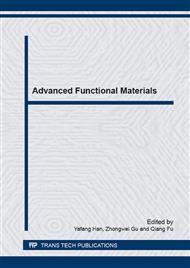p.103
p.109
p.115
p.125
p.129
p.135
p.141
p.149
p.154
Effect of Ag Addition on Growth of the Interfacial Intermetallic Compounds between Sn-0.7Cu Solder and Cu Substrate
Abstract:
The effect of Ag content on the morphology of the intermetallic compound (IMC) layer at the interface between Sn-xAg-0.7Cu (x=0.0 wt.%, 0.3 wt.%, 0.8 wt.%, 3.0 wt.%) and Cu substrate has been investigated. After reflow, the slight addition of Ag element can suppress the growth of IMC. However, as the Ag content increases, the thickness of IMC is enhanced. After aging at 150°C, the IMC growth rate constant decreases with the addition of Ag. The IMC growth rate constant of Sn-3.0Ag-0.7Cu is 0.94864×10-5 μm2/s, which is the lowest among these solders. As the Ag addition is 0.8wt% and 3.0wt%, the Cu3Sn growth rate constant is 0.16641×10-5 μm2/s and 0.18496×10-5μm2/s, compared to the Sn-0.7Cu solder decreased 54% and 49%, respectively. As a result, the addition of Ag element improves the anti-aging properties and suppresses the growth of Cu3Sn layer, which leads to the improvement of solder joint reliability.
Info:
Periodical:
Pages:
129-134
Citation:
Online since:
March 2015
Authors:
Keywords:
Price:
Сopyright:
© 2015 Trans Tech Publications Ltd. All Rights Reserved
Share:
Citation:


